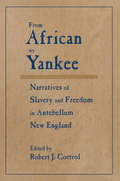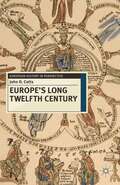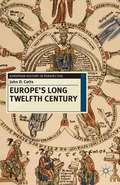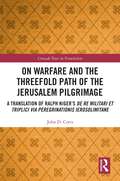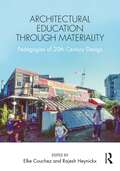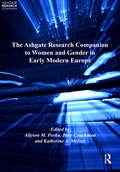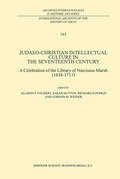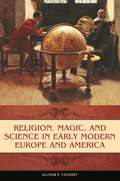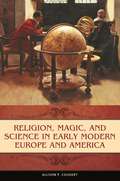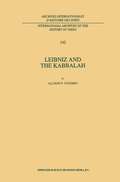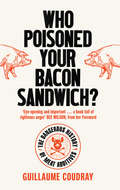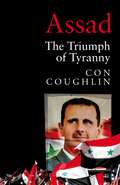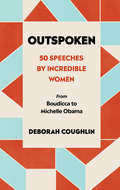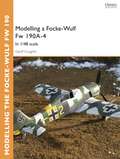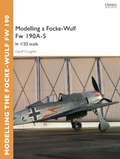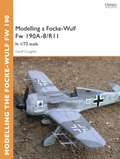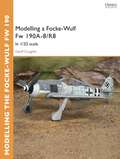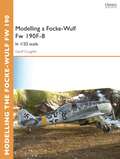- Table View
- List View
From African to Yankee: Narratives of Slavery and Freedom in Antebellum New England
by Robert J. CottrolAn anthology of five of the best autobiographical narratives detailing black life in New England in the late eighteenth and nineteenth centuries. The volume is accompanied by Cottrol's introduction, which discusses their significance and the window that they open on the lives of black New Englanders as they moved from eighteenth century slavery to freedom and the struggle for equality in the nineteenth century.
Europe's Long Twelfth Century: Order, Anxiety and Adaptation, 1095-1229 (European History in Perspective)
by John CottsBetween 1095 and 1229, Western Europe confronted a series of alternative cultural possibilities that would fundamentally transform its social structures, its intellectual life, and its very identity. It was a period of difficult decisions and anxiety rather than a triumphant 'renaissance'.In this fresh reassessment of the twelfth century, John D. Cotts:• shows how new social, economic and religious options challenged Europeans to re-imagine their place in the world• provides an overview of political life and detailed examples of the original thought and religious enthusiasm of the time• presents the Crusades as the century's defining movement.Ideal for students and scholars alike, this is an essential overview of a pivotal era in medieval history that arguably paved the way for a united Europe.
Europe's Long Twelfth Century: Order, Anxiety And Adaptation, 1095-1229 (PDF)
by John D. CottsBetween 1095 and 1229, Western Europe confronted a series of alternative cultural possibilities that would fundamentally transform its social structures, its intellectual life, and its very identity. It was a period of difficult decisions and anxiety rather than a triumphant "renaissance. " In this fresh reassessment of the twelfth century, John D. Cotts: * shows how new social, economic and religious options challenged Europeans to re-imagine their place in the world * provides an overview of political life and detailed examples of the original thought and religious enthusiasm of the time * presents the Crusades as the century's defining movement. Ideal for students and scholars alike, this is an essential overview of a pivotal era in medieval history that arguably paved the way for a united Europe.
On Warfare and the Threefold Path of the Jerusalem Pilgrimage: A Translation of Ralph Niger’s De re militari et triplici via peregrinationis Ierosolimitane (Crusade Texts in Translation)
by John D CottsThis volume will provide the first English translation of Ralph Niger’s critical reflection on military pilgrimage, written in the late 1180s in response to the calling of the Third Crusade. Long known to scholars as early and highly idiosyncratic critique of crusading, On Warfare and the Threefold Path of the Jerusalem Pilgrimage provides a sustained reflection on penance, the meaning of Jerusalem, and the challenges of military expeditions to the Levant. After the fall of Jerusalem, he resisted the calls to crusade and instead exhorted on Christians to look inward and build Jerusalem in their hearts. Throughout the four books of the work, Ralph looks to scripture for precedents for crusading and finds none. However, by ranging widely over examples of Old Testament violence and considering the Heavenly and Earthly Jerusalem together. On Warfare offers a unique perspective on how the Bible informed contemporary views of the Crusades. Methodically examining pilgrimage through the lens of scripture, Ralph surveys the entire semantic field of crusading, and concludes that Christian knights could do more good by staying home than going on a military adventure to the Holy Land.
On Warfare and the Threefold Path of the Jerusalem Pilgrimage: A Translation of Ralph Niger’s De re militari et triplici via peregrinationis Ierosolimitane (Crusade Texts in Translation)
by John D CottsThis volume will provide the first English translation of Ralph Niger’s critical reflection on military pilgrimage, written in the late 1180s in response to the calling of the Third Crusade. Long known to scholars as early and highly idiosyncratic critique of crusading, On Warfare and the Threefold Path of the Jerusalem Pilgrimage provides a sustained reflection on penance, the meaning of Jerusalem, and the challenges of military expeditions to the Levant. After the fall of Jerusalem, he resisted the calls to crusade and instead exhorted on Christians to look inward and build Jerusalem in their hearts. Throughout the four books of the work, Ralph looks to scripture for precedents for crusading and finds none. However, by ranging widely over examples of Old Testament violence and considering the Heavenly and Earthly Jerusalem together. On Warfare offers a unique perspective on how the Bible informed contemporary views of the Crusades. Methodically examining pilgrimage through the lens of scripture, Ralph surveys the entire semantic field of crusading, and concludes that Christian knights could do more good by staying home than going on a military adventure to the Holy Land.
Architectural Education Through Materiality: Pedagogies of 20th Century Design
by Elke CouchezWhat kind of architectural knowledge was cultivated through drawings, models, design-build experimental houses and learning environments in the 20th century? And, did new teaching techniques and tools foster pedagogical, institutional and even cultural renewal? Architectural Education Through Materiality: Pedagogies of 20th Century Design brings together a collection of illustrated essays dedicated to exploring the complex processes that transformed architecture’s pedagogies in the 20th century. The last decade has seen a substantial increase in interest in the history of architectural education. This book widens the geographical scope beyond local school histories and sets out to discover the very distinct materialities and technologies of schooling as active agents in the making of architectural schools. Architectural Education Through Materiality argues that knowledge transmission cannot be reduced to ‘software’, the relatively easily detectable ideas in course notes and handbooks, but also has to be studied in close relation to the ‘hardware’ of, for instance, wall pictures, textiles, campus designs, slide projectors and even bodies. Presenting illustrated case studies of works by architects, educators and theorists including Dalibor Vesely, Dom Hans van der Laan, the Global Tools group Heinrich Wölfflin, Alfons Hoppenbrouwers, Joseph Rykwert, Pancho Guedes and Robert Cummings, and focusing on student-led educational initiatives in Europe, the UK, North America and Australia, the book will inspire students, educators and professionals with an interest in the many ways architectural knowledge is produced and taught.
Architectural Education Through Materiality: Pedagogies of 20th Century Design
by Elke Couchez Rajesh HeynickxWhat kind of architectural knowledge was cultivated through drawings, models, design-build experimental houses and learning environments in the 20th century? And, did new teaching techniques and tools foster pedagogical, institutional and even cultural renewal? Architectural Education Through Materiality: Pedagogies of 20th Century Design brings together a collection of illustrated essays dedicated to exploring the complex processes that transformed architecture’s pedagogies in the 20th century. The last decade has seen a substantial increase in interest in the history of architectural education. This book widens the geographical scope beyond local school histories and sets out to discover the very distinct materialities and technologies of schooling as active agents in the making of architectural schools. Architectural Education Through Materiality argues that knowledge transmission cannot be reduced to ‘software’, the relatively easily detectable ideas in course notes and handbooks, but also has to be studied in close relation to the ‘hardware’ of, for instance, wall pictures, textiles, campus designs, slide projectors and even bodies. Presenting illustrated case studies of works by architects, educators and theorists including Dalibor Vesely, Dom Hans van der Laan, the Global Tools group Heinrich Wölfflin, Alfons Hoppenbrouwers, Joseph Rykwert, Pancho Guedes and Robert Cummings, and focusing on student-led educational initiatives in Europe, the UK, North America and Australia, the book will inspire students, educators and professionals with an interest in the many ways architectural knowledge is produced and taught.
The Ashgate Research Companion to Women and Gender in Early Modern Europe
by Jane CouchmanOver the past three decades scholars have transformed the study of women and gender in early modern Europe. This Ashgate Research Companion presents an authoritative review of the current research on women and gender in early modern Europe from a multi-disciplinary perspective. The authors examine women’s lives, ideologies of gender, and the differences between ideology and reality through the recent research across many disciplines, including history, literary studies, art history, musicology, history of science and medicine, and religious studies. The book is intended as a resource for scholars and students of Europe in the early modern period, for those who are just beginning to explore these issues and this time period, as well as for scholars learning about aspects of the field in which they are not yet an expert. The companion offers not only a comprehensive examination of the current research on women in early modern Europe, but will act as a spark for new research in the field.
The Ashgate Research Companion to Women and Gender in Early Modern Europe
by Jane CouchmanOver the past three decades scholars have transformed the study of women and gender in early modern Europe. This Ashgate Research Companion presents an authoritative review of the current research on women and gender in early modern Europe from a multi-disciplinary perspective. The authors examine women’s lives, ideologies of gender, and the differences between ideology and reality through the recent research across many disciplines, including history, literary studies, art history, musicology, history of science and medicine, and religious studies. The book is intended as a resource for scholars and students of Europe in the early modern period, for those who are just beginning to explore these issues and this time period, as well as for scholars learning about aspects of the field in which they are not yet an expert. The companion offers not only a comprehensive examination of the current research on women in early modern Europe, but will act as a spark for new research in the field.
Judaeo-Christian Intellectual Culture in the Seventeenth Century: A Celebration of the Library of Narcissus Marsh (1638–1713) (International Archives of the History of Ideas Archives internationales d'histoire des idées #163)
by A. P. Coudert S. Hutton R. H. Popkin G. M. WeinerMURIEL MCCARTHY This volume originated from a seminar organised by Richard H. Popkin in Marsh's Library on July 7-8, 1994. It was one of the most stimulating events held in the Library in recent years. Although we have hosted many special seminars on such subjects as rare books, the Huguenots, and Irish church history, this was the first time that a seminar was held which was specifically related to the books in our own collection. It seems surprising that this type of seminar has never been held before although the reason is obvious. Since there is no printed catalogue of the Library scholars are not aware of its contents. In fact the collection of books by late seventeenth and early eighteenth century European authors on, for example, such subjects as biblical criticism, political and religious controversy, is one of the richest parts of the Library's collections. Some years ago we were informed that of the 25,000 books in Marsh's at least 5,000 English books or books printed in England were printed between 1640 and 1700.
Religion, Magic, and Science in Early Modern Europe and America (Praeger Series on the Early Modern World)
by Allison P. CoudertThis fascinating study looks at how the seemingly incompatible forces of science, magic, and religion came together in the 15th, 16th, and 17th centuries to form the foundations of modern culture.As Religion, Magic, and Science in Early Modern Europe and America makes clear, the early modern period was one of stark contrasts: witch burnings and the brilliant mathematical physics of Isaac Newton; John Locke's plea for tolerance and the palpable lack of it; the richness of intellectual and artistic life, and the poverty of material existence for all but a tiny percentage of the population. Yet, for all the poverty, insecurity, and superstition, the period produced a stunning galaxy of writers, artists, philosophers, and scientists.This book looks at the conditions that fomented the emergence of such outstanding talent, innovation, and invention in the period 1450 to 1800. It examines the interaction between religion, magic, and science during that time, the impossibility of clearly differentiating between the three, and the impact of these forces on the geniuses who laid the foundation for modern science and culture.
Religion, Magic, and Science in Early Modern Europe and America (Praeger Series on the Early Modern World)
by Allison P. CoudertThis fascinating study looks at how the seemingly incompatible forces of science, magic, and religion came together in the 15th, 16th, and 17th centuries to form the foundations of modern culture.As Religion, Magic, and Science in Early Modern Europe and America makes clear, the early modern period was one of stark contrasts: witch burnings and the brilliant mathematical physics of Isaac Newton; John Locke's plea for tolerance and the palpable lack of it; the richness of intellectual and artistic life, and the poverty of material existence for all but a tiny percentage of the population. Yet, for all the poverty, insecurity, and superstition, the period produced a stunning galaxy of writers, artists, philosophers, and scientists.This book looks at the conditions that fomented the emergence of such outstanding talent, innovation, and invention in the period 1450 to 1800. It examines the interaction between religion, magic, and science during that time, the impossibility of clearly differentiating between the three, and the impact of these forces on the geniuses who laid the foundation for modern science and culture.
Leibniz and the Kabbalah (International Archives of the History of Ideas Archives internationales d'histoire des idées #142)
by A.P. CoudertThe general view of scholars is that the Kabbalah had no meaningful influence on Leibniz's thought. } But on the basis of new evidence I am convinced that the question must be reopened. The Kabbalah did influence Leibniz, and a recognition of this will lead to both a better understanding of the supposed "quirkiness,,2 of Leibniz's philosophy and an appreciation ofthe Kabbalah as an integral but hitherto ignored factor in the emergence of the modem secular and scientifically oriented world. During the past twenty years there has been increasing willingness to recognize the important ways in which mystical and occult thinking contributed to the development of science and the emergence 3 of toleration. However, the Kabbalah, particularly the Lurianic Kabbalah with its monistic vitalism and optimistic philosophy of perfectionism and universal salvation, has not yet been integrated into the new historiography, although it richly deserves to be. On the basis of manuscripts in libraries at Hanover and Wolfenbiittel, it is clear that Leibniz's relationship with Francis Mercury van Helmont (1614- 1698) and Christian Knorr von Rosenroth (1636-1689), the two leading Christian Kabbalists of the period, was much closer than previously imagined and that his direct knowledge of their writings, especially the collection of 4 kabbalistic texts they published in the Kabbala Denudata, was far more detailed than most scholars have realized. During 1688 Leibniz spent more than a month at Sulzbach with von Rosenroth.
Who Poisoned Your Bacon Sandwich?: The Dangerous History of Meat Additives
by Guillaume Coudray'Eye-opening and important . . . a book full of righteous anger' Bee Wilson, from her Foreword Did you know that bacon, ham, hot dogs and salami are classified by the World Health Organization (WHO) as ‘category 1 carcinogens’? Would you eat them if you knew they caused bowel cancer? Following ten years of detailed investigation, documentary film-maker Guillaume Coudray presents a powerful examination of the use of nitro-additives in meat. As he reveals, most mass-produced processed meats, and now even many ‘artisanal’ products, contain chemicals that react with meat to form cancer-causing compounds. He tells the full story of how, since the 1970s, the meat-processing industry has denied the health risks because these additives make curing cheaper and quicker, extending shelf life and giving meat a pleasing pink colour. These additives are, in fact, unnecessary. Parma ham has not contained them for nearly 30 years – and indeed all traditional cured meats were once produced without nitrate and nitrite. Progressive producers are now increasingly following that example. Who Poisoned Your Bacon Sandwich? – featuring a foreword by acclaimed food writer Bee Wilson – is the authoritative, gripping and scandalous story of big business flying in the face of scientific health warnings. It allows you to evaluate the risks, and carries a message of hope that things can change.
Assad: The Triumph of Tyranny
by Con Coughlin'Important, compelling, and detailed . . . a superb analysis of the West’s policy missteps and the tragic consequences of them.' - General David PetraeusIn Assad: The Triumph of Tyranny, Con Coughlin, veteran commentator on war in the Middle East and author of Saddam: The Secret Life, examines how a mild-mannered ophthalmic surgeon has transformed himself into the tyrannical ruler of a once flourishing country.Until the Arab Spring of 2011, the world’s view of Bashar al-Assad was largely benign. He and his wife, a former British banker, were viewed as philanthropic individuals doing their best to keep their country at peace. So much so that a profile of Mrs Assad in American Vogue was headlined ‘The Rose in the Desert’. Shortly after it appeared, Syria descended into the horrific civil war that has seen its cities reduced to rubble and thousands murdered and displaced, a civil war that is still raging over a decade later.In this vivid and authoritative account Con Coughlin draws together all the strands of Assad's remarkable story, revealing precisely how a young doctor ensured not only that he inherited the presidency from his father, but has held on to power by whatever means necessary, continuing to preside over one of the most brutal regimes of modern times.
Outspoken: 50 Speeches by Incredible Women from Boudicca to Michelle Obama
by Deborah CoughlinHistory didn’t listen to women, but that never stopped them from speaking out …A lot of history is made up of speeches. Speeches about big ideas, celebratory speeches, rousing speeches to inspire soldiers to fight to the death, comic speeches to help us see the funny side to life. From Jesus to Winston Churchill to Martin Luther King Jr. and even Donald Trump, we’ve been raised with the words of important men ringing in our ears …But where are all the women? Unless you’re the type of person who loves researching suffrage speeches, you are unlikely to know many soundbites from women throughout history. Outspoken: 50 Speeches by Incredible Women is going to change that. From Joan of Arc and Virginia Woolf, to Oprah Winfrey and Greta Thunberg, this is a celebration of outstanding and outspoken women everywhere.
Modelling a Focke-Wulf Fw 190A-4: In 1/48 scale (Osprey Modelling Guides)
by Geoff CoughlinThe Focke-Wulf Fw 190 is regarded as one of the best fighters of World War II. Designed by Kurk Tank, it first saw combat in the summer of 1941 and went on to be produced in several variants. It remains hugely popular subject for aviation scale-modellers. This title provides a detailed, step-by-step guide to modelling the Focke-Wulf Fw 190A-4 in 1/48 scale. Key aspects such as finishing techniques, including painting and displaying your model are covered. This guide forms part of Osprey Modelling 27 Modelling the Focke-Wulf Fw 190 A, F and G also available as an ebook.
Modelling a Focke-Wulf Fw 190A-4: In 1/48 scale (Osprey Modelling Guides)
by Geoff CoughlinThe Focke-Wulf Fw 190 is regarded as one of the best fighters of World War II. Designed by Kurk Tank, it first saw combat in the summer of 1941 and went on to be produced in several variants. It remains hugely popular subject for aviation scale-modellers. This title provides a detailed, step-by-step guide to modelling the Focke-Wulf Fw 190A-4 in 1/48 scale. Key aspects such as finishing techniques, including painting and displaying your model are covered. This guide forms part of Osprey Modelling 27 Modelling the Focke-Wulf Fw 190 A, F and G also available as an ebook.
Modelling a Focke-Wulf Fw 190A-5: In 1/32 scale (Osprey Modelling Guides #8)
by Geoff CoughlinThe Focke-Wulf Fw 190 is regarded as one of the best fighters of World War II. Designed by Kurk Tank, it first saw combat in the summer of 1941 and went on to be produced in several variants. It remains hugely popular subject for aviation scale-modellers. This title provides a detailed, step-by-step guide to modelling the Focke-Wulf Fw 190A-5 in 1/32 scale. Key aspects such as finishing techniques, including painting and displaying your model are covered. This guide forms part of Osprey Modelling 27 Modelling the Focke-Wulf Fw 190 A, F and G also available as an ebook.
Modelling a Focke-Wulf Fw 190A-5: In 1/32 scale (Osprey Modelling Guides)
by Geoff CoughlinThe Focke-Wulf Fw 190 is regarded as one of the best fighters of World War II. Designed by Kurk Tank, it first saw combat in the summer of 1941 and went on to be produced in several variants. It remains hugely popular subject for aviation scale-modellers. This title provides a detailed, step-by-step guide to modelling the Focke-Wulf Fw 190A-5 in 1/32 scale. Key aspects such as finishing techniques, including painting and displaying your model are covered. This guide forms part of Osprey Modelling 27 Modelling the Focke-Wulf Fw 190 A, F and G also available as an ebook.
Modelling a Focke-Wulf Fw 190A-8/R11: In 1/72 scale (Osprey Modelling Guides #7)
by Geoff CoughlinThe Focke-Wulf Fw 190 is regarded as one of the best fighters of World War II. Designed by Kurt Tank, it first saw combat in the summer of 1941 and went on to be produced in several variants. It remains a hugely popular subject for aviation scale-modellers. This title provides a detailed, step-by-step guide to modelling the Focke-Wulf Fw 190A-8/RII in 1/72 scale. Key aspects such as finishing techniques, including painting and displaying your model are covered. This guide forms part of Osprey Modelling 27 Modelling the Focke-Wulf Fw 190 A, F and G also available as an ebook.
Modelling a Focke-Wulf Fw 190A-8/R11: In 1/72 scale (Osprey Modelling Guides)
by Geoff CoughlinThe Focke-Wulf Fw 190 is regarded as one of the best fighters of World War II. Designed by Kurt Tank, it first saw combat in the summer of 1941 and went on to be produced in several variants. It remains a hugely popular subject for aviation scale-modellers. This title provides a detailed, step-by-step guide to modelling the Focke-Wulf Fw 190A-8/RII in 1/72 scale. Key aspects such as finishing techniques, including painting and displaying your model are covered. This guide forms part of Osprey Modelling 27 Modelling the Focke-Wulf Fw 190 A, F and G also available as an ebook.
Modelling a Focke-Wulf Fw 190A-8/R8: In 1/32 scale (Osprey Modelling Guides)
by Geoff CoughlinThe Focke-Wulf Fw 190 is regarded as one of the best fighters of World War II. Designed by Kurk Tank, it first saw combat in the summer of 1941 and went on to be produced in several variants. It remains hugely popular subject for aviation scale-modellers. This title provides a detailed, step-by-step guide to modelling the Focke-Wulf Fw 190A-8/R8 in 1/32 scale. Key aspects such as finishing techniques, including painting and displaying your model are covered. This guide forms part of Osprey Modelling 27 Modelling the Focke-Wulf Fw 190 A, F and G also available as an ebook.
Modelling a Focke-Wulf Fw 190A-8/R8: In 1/32 scale (Osprey Modelling Guides)
by Geoff CoughlinThe Focke-Wulf Fw 190 is regarded as one of the best fighters of World War II. Designed by Kurk Tank, it first saw combat in the summer of 1941 and went on to be produced in several variants. It remains hugely popular subject for aviation scale-modellers. This title provides a detailed, step-by-step guide to modelling the Focke-Wulf Fw 190A-8/R8 in 1/32 scale. Key aspects such as finishing techniques, including painting and displaying your model are covered. This guide forms part of Osprey Modelling 27 Modelling the Focke-Wulf Fw 190 A, F and G also available as an ebook.
Modelling a Focke-Wulf Fw 190F-8: In 1/32 scale (Osprey Modelling Guides #11)
by Geoff CoughlinThe Focke-Wulf Fw 190 is regarded as one of the best fighters of World War II. Designed by Kurk Tank, it first saw combat in the summer of 1941 and went on to be produced in several variants. It remains hugely popular subject for aviation scale-modellers. This title provides a detailed, step-by-step guide to modelling the Focke-Wulf Fw 190F-8 in 1/32 scale. Key aspects such as finishing techniques, including painting and displaying your model are covered. This guide forms part of Osprey Modelling 27 Modelling the Focke-Wulf Fw 190 A, F and G also available as an ebook.
